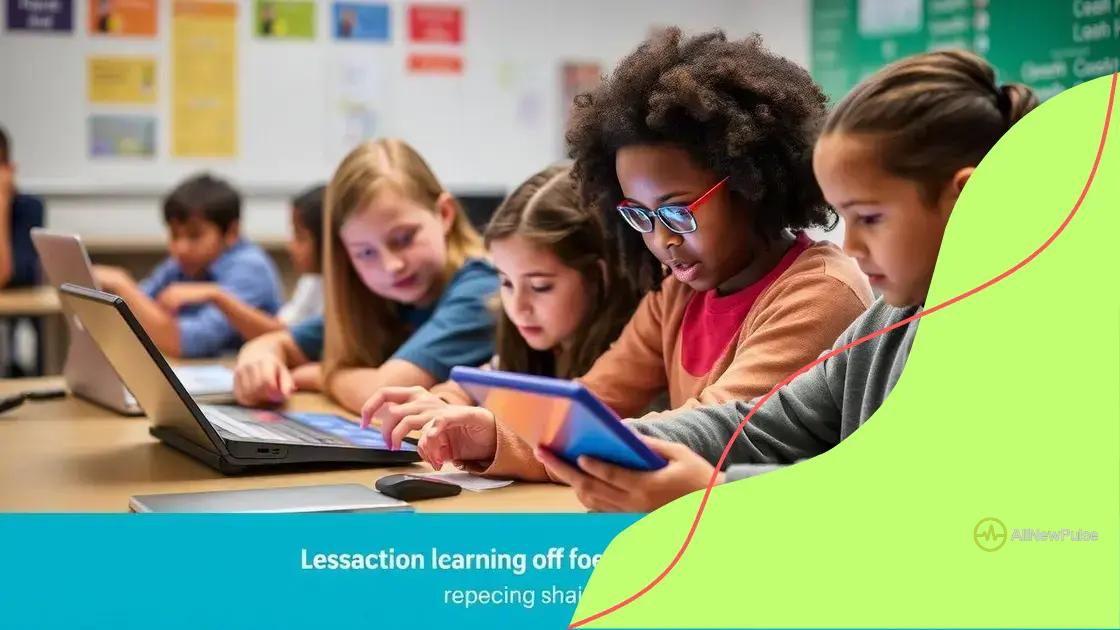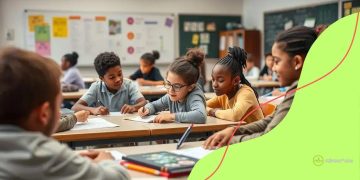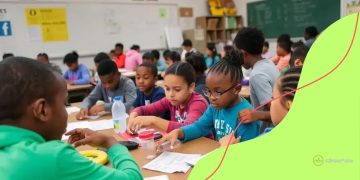The future of educational textbooks and resources

The future of educational textbooks and resources involves personalized learning, interactive content, mobile accessibility, and open educational resources, revolutionizing how knowledge is shared and consumed in classrooms.
The future of educational textbooks and resources is here, and it’s reshaping how we learn. Imagine accessing a wealth of knowledge right at your fingertips! Are you ready to discover the changes coming to education?
The evolution of educational materials
The evolution of educational materials has transformed the way students learn. In earlier days, textbooks were the primary source of knowledge. They provided static information that many had to rely on. Today, educational materials are evolving rapidly, integrating technology into the learning experience.
From Print to Digital
One of the most significant changes has been the shift from print to digital formats. Digital textbooks offer many advantages.
- Access to updated information instantly
- Interactive elements that engage students
- Resources available on multiple devices
- Reduced environmental impact
These factors make it clear why so many educators are embracing digital solutions.
Expanding Learning Resources
In addition to traditional textbooks, today’s learning resources include online articles, videos, and interactive modules. Each of these formats caters to different learning styles and preferences. For instance, visual learners benefit from videos, while auditory learners may prefer podcasts.
Moreover, platforms like educational apps and websites have emerged, allowing students to explore topics in-depth, often at their own pace. This flexibility transforms the educational experience, making it more personalized.
As educators adopt these innovative materials, they also create a more engaging and effective environment for their students. By integrating immersive technologies like Augmented Reality (AR) and Virtual Reality (VR), they further enhance learning. These technologies can bring complex subjects to life, making them more relatable and easier to understand.
In conclusion, the evolution of educational materials underscores a shift towards flexible, interactive, and engaging resources that redefine how learning occurs in classrooms.
Benefits of digital textbooks
The benefits of digital textbooks are numerous, especially in today’s fast-paced educational environment. As students increasingly rely on technology, these resources offer unique advantages that traditional print books cannot match.
Accessibility and Convenience
One significant benefit is their accessibility. Digital textbooks can be accessed from various devices, such as tablets, laptops, and smartphones. This means students can learn anytime and anywhere, making education more convenient.
- Instant access to resources
- No heavy backpacks needed
- Searchable content for easy navigation
- Ability to carry multiple books in one device
These features empower students to take charge of their learning.
Cost Effectiveness
Another advantage is cost. Digital textbooks are often less expensive than their print counterparts. Publishers can provide updates more easily and reduce costs associated with printing and shipping. As a result, students can save money while still obtaining quality educational materials.
Additionally, many digital platforms offer free resources or low-cost subscriptions, further enhancing affordability.
Digital textbooks also encourage interactive learning. Features like embedded videos, quizzes, and discussion forums create an engaging experience. These elements help students grasp complex concepts and improve retention.
With built-in annotation tools, learners can highlight important information, take notes, and organize their thoughts effectively. This interaction promotes a more active form of learning, which can lead to better understanding and improved performance.
In a world where technology is constantly evolving, adapting to digital formats is essential. The benefits of digital textbooks illustrate how they can enhance the educational experience, making learning more accessible, affordable, and engaging for students.
How technology enhances learning resources

Technology enhances learning resources in many exciting ways. As schools and colleges adopt advanced tools, students benefit from richer educational experiences.
Interactive Learning Tools
One way technology improves education is through interactive learning tools. These resources make lessons more engaging and accessible.
- Educational games that make learning fun
- Simulation software to practice real-world skills
- Online quizzes for immediate feedback
- Collaborative platforms for group projects
By incorporating these elements, students are more likely to stay interested and retain information.
Multimedia Content
Another benefit is the use of multimedia. Videos, podcasts, and animations make complex topics easier to understand. These resources cater to different learning styles, allowing students to explore subjects in their preferred formats.
For instance, a student struggling with a math concept may benefit from watching tutorial videos that break down the material step by step. This tailored approach can help them grasp challenging concepts.
Furthermore, digital resources are constantly updated, ensuring students have access to the latest information. This dynamic nature contrasts with traditional textbooks, which can quickly become outdated.
Through online libraries and educational websites, learners can easily find and utilize current resources. This access to information fosters research skills and encourages lifelong learning.
In addition, technology promotes personalized learning. Adaptive learning software adjusts lessons based on a student’s performance, allowing them to progress at their own pace. This flexibility supports diverse learning needs and enhances overall understanding.
As technology continues to evolve, the future of educational resources is bright, providing students with powerful tools to enhance their learning experiences.
The role of interactive content
The role of interactive content in education has become increasingly important. It offers engaging ways for students to learn and participate in their studies. This interactive format encourages active learning, making it easier for students to grasp complex topics.
Engagement Through Interaction
One key benefit of interactive content is that it keeps students engaged. Traditional learning methods can sometimes feel boring or repetitive. However, with interactive elements, such as quizzes and games, students are more likely to pay attention.
- Immediate feedback through interactive quizzes
- Learning games that reinforce concepts
- Multimedia tools like videos and animations
- Virtual simulations for hands-on practice
This level of engagement helps students retain information better.
Collaboration and Communication
Interactive content also promotes collaboration among students. Many platforms allow classmates to work together on projects or engage in discussions. This collaboration builds teamwork skills and encourages sharing of ideas.
Furthermore, teachers can use interactive tools to foster communication. For instance, they can create online discussion boards where students post questions or share insights. This setup facilitates a more open and inclusive learning environment.
Additionally, interactive content allows educators to tailor lessons to meet diverse learning needs. By incorporating various types of interactive resources, teachers can address different learning styles, ensuring that all students have a chance to succeed.
As technology advances, the role of interactive content in education will only continue to grow. It offers endless possibilities for enriching the learning experience, making education more effective and enjoyable.
Future trends in educational publishing
The future trends in educational publishing are shaping the way knowledge is shared and consumed in classrooms. As technology advances, publishers are finding innovative ways to engage students and cater to their diverse learning needs.
Personalized Learning Experiences
One significant trend is the rise of personalized learning experiences. Publishers are developing adaptive learning technologies that tailor content to individual learners. This means that students receive materials that match their skill levels and learning styles.
- Content that adapts based on performance
- Customized recommendations for further study
- Increased motivation through targeted challenges
- Support for diverse learning abilities
Such personalization enhances student engagement and improves outcomes.
Integration of Multimedia and Interactive Content
Another trend is the integration of multimedia and interactive content. Publishers are moving away from static textbooks toward dynamic resources that include videos, animations, and interactive quizzes. This transition makes learning more engaging and effective.
These dynamic resources can also facilitate collaboration among peers, encouraging teamwork and communication. Students can work together on projects using shared digital platforms that enhance their learning experience.
Moreover, mobile learning is on the rise. As more students own smartphones and tablets, publishers are creating educational apps that allow learning on-the-go. This convenience helps students fit learning into their busy lives.
Additionally, open educational resources (OER) are gaining traction. These freely accessible materials provide high-quality content at no cost, making education more equitable. OER allows educators to adapt and share resources, fostering a collaborative approach to learning.
In conclusion, the future trends in educational publishing emphasize personalization, multimedia integration, collaboration, and accessibility. These changes are set to revolutionize how students and educators interact with learning materials.
FAQ – Frequently Asked Questions about the Future of Educational Publishing
What is personalized learning?
Personalized learning tailors educational experiences to the individual needs of each student, helping them learn at their own pace.
How does interactive content benefit students?
Interactive content engages students through quizzes and games, making learning more enjoyable and effective.
What is mobile learning?
Mobile learning allows students to access educational resources on their smartphones and tablets, enabling learning anytime, anywhere.
What are open educational resources (OER)?
Open educational resources are freely accessible materials that provide high-quality content, promoting equity in education.





